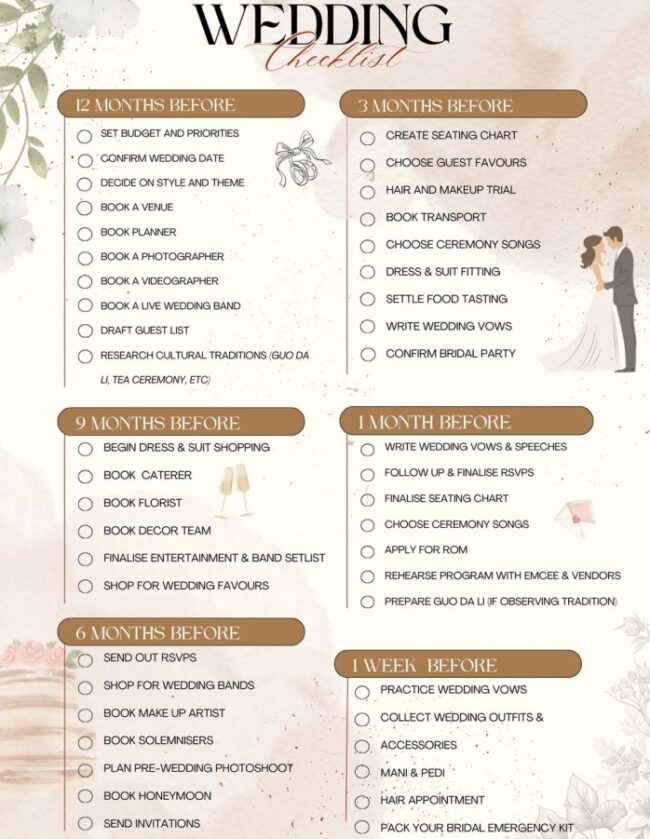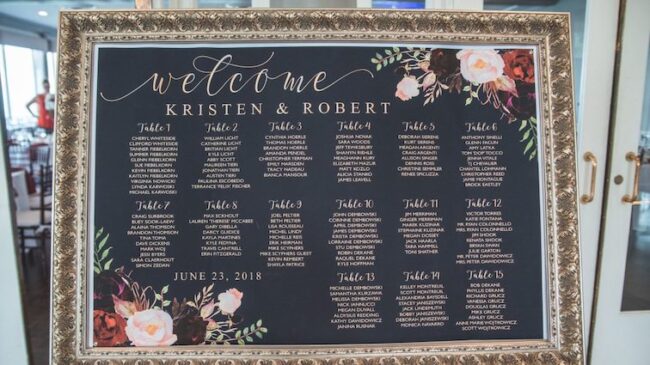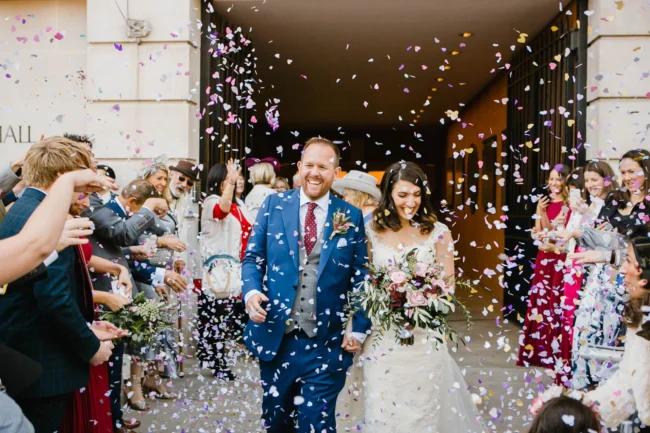You’re not simply planning a wedding; you’re shaping a day that feels deeply yours – every moment, every detail, captured just the way you’ve always pictured it.
Right out of the gate, start with big-picture questions: What atmosphere do you want (romantic garden? modern loft? cozy barn?) What’s more important to you – food, music, guest experience, or design? Envision your ideal guest walking in: what do they notice first? What do they remember?
When couples begin seriously planning, nearly 52% do so about 12 months in advance – giving themselves breathing space to refine and shift without scrambling.
That’s a smart timeline to aim for. Use this phase to gather inspiration, narrow your palette or vibe, and define your non-negotiables. This clarity will guide every later decision.
1. Organizing with a Master Plan

To keep momentum and sanity, you need a strong roadmap. That’s where your wedding checklist comes in – a firm spine for all your details. A good checklist covers everything from vendor deadlines to dress fittings to seating chart finalization. Break it into “what to do at 12 months out,” “6 months out,” “1 month out,” and “week of.”
Here’s a sample timeline table to get you started:
| Time Before Wedding | Key Tasks |
| 12+ months | Reserve venue, book major vendors, draft guest list |
| 9–6 months | Send save-the-dates, order dress, choose décor |
| 3 months | Finalize menu, seating chart draft, logistics |
| 1 month | Confirm vendors, distribute timeline, pack kit |
| Week of / day of | Rehearsal, set-up, final walk-through, breathing space |
Treat that table as your backbone. Tweak it to your style, and revisit every few weeks to reflect progress. A structured roadmap helps you delegate better and avoid last-minute chaos.
2. Budget Realities and Smart Decisions
Money talk is seldom romantic, but it’s essential. Setting your budget is like sketching the frame before painting the picture. Start with a total you feel comfortable spending, then divide it across categories – but always reserve 5 – 10% for surprises (trust me, they’ll come).
More than half of couples report that inflation or economic pressures affect their wedding plans – and about 53% admit they end up overspending by an average of $7,347.
To stay sane, decide in advance which line items can flex (favors, signage, extra rentals) and which are locked (venue, food, photography). If a vendor quote exceeds expectations, you’re ready to say “no, thanks” or swap for a creative compromise.
Tip: Build your budget in a spreadsheet, track deposits vs. due dates, and revisit at each planning milestone.
3. Choosing Your Venue and Logistics First
The venue is your foundational character – it shapes guest flow, decor, and even your timeline. So before you choose linens or flowers, lock down place and date.
- Visit in person whenever possible.
- Walk the space several times, looking at how light changes, imagining guest circulation, and testing acoustics.
- Ask: Does it fit your vision?
- Are there hidden fees for setup or teardown?
- Any restrictions (candles, confetti, hours)?
A smart contract protects you – carefully read clauses on deposits, cancellation, and overtime. Many couples now demand clear terms on weather backup (for outdoor venues).
In 2025, couples are more cautious: 85% expect inflation or cost changes, and 41% plan to trim guest lists or adjust details rather than nasty surprises. Getting the venue right gives everything else room to shine.

4. Building Your Vendor Team: Trust, Style and Communication
Even the most beautiful wedding fails if vendors don’t work together. Start your vendor search by style and availability, then assess personality and responsiveness. Witness how they react to feedback, whether they propose creative solutions, and whether they seem invested in your vision.
Here’s a quick checklist for vendor selection:
- Review portfolios and full events (not just best shots)
- Ask for recent day-of references
- Confirm all costs, overtime, and travel fees in writing
- Maintain regular communication and milestone check-ins
Did you know? Couples tend to hire 10–14 vendors on average. That’s a lot of relationships to coordinate. Give each vendor access to the shared master timeline, and make sure every contractor knows where to show up, when, and how.
5. Style, Decor and Personal Touches
Once the bones are in place, it’s time to breathe life into your day. Begin by selecting a color palette or mood board. Then layer in texture (linen, lace, greenery), lighting (uplights, candles, fairy lights), and focal points (altar, dessert table). Focus your decor budget on high-impact zones: entrance, backdrops, ceremony arbor, and sweetheart table.
Did you know? Modern couples are dropping uniform bridesmaid dresses: as of 2024, only 15% of parties wear identical gowns. That flexibility lets each person shine while still feeling cohesive.
Balance beauty with comfort. A gorgeous space that’s cold, dim, or poorly lit won’t feel magical in real life.
6. Guest Experience and Flow Planning
Weddings are really about people: creating moments that linger in the mind. Think ahead: how do guests arrive? Do they have a cocktail hour or a welcome drink? Are restrooms easy to access? Is the walk from the ceremony to the reception smooth? Every step matters.
Personal touches help anchor meaning. I often suggest couples include:
- Icebreaker games at tables
- Handwritten notes at place settings
- A late-night snack bar
- Signage with fun facts about the couple
Remember: pacing is key. Give guests breathing room between ceremony, cocktail hour, dinner, and dancing. Too much downtime feels awkward; too little feels rushed. Guests may remember how easy the transitions were more than they remember the cake flavor.
7. Final Weeks, Coordination and Contingencies
In the last 3–4 weeks, you move into execution mode. Confirm delivery and arrival times with every vendor. Share an hour-by-hour “day-of” schedule with family, vendors, and your wedding party. Walk the venue in your mind, from setup to teardown.
Pack an emergency kit with essentials: safety pins, stain wipes, sewing kit, snacks, extra shoes, first aid. Assign a point person (planner, MOH, trusted friend) to handle vendor questions on the day so you don’t have to.
Subnote: One of my favorite tricks is creating a “bubble map” for vendor spacing—diagram all tables, stations, cake, DJ, flow—to see potential pinch points. It uncovers hidden logistical conflicts before they arise.
8. Staying Present and Enjoying Your Day
Even the best-laid plans may wobble. A late delivery or sudden rain doesn’t have to ruin the magic. The secret is presence: ground yourself in the moment. Take a few quiet breaths when you wake, walk through your favorite corner of the venue, or pause with your partner before the ceremony begins.
Trust your vendors. If you’ve communicated well, handed over the logistics, and prepared contingencies—let them carry the day. Let go of perfection. Some of the sweetest wedding memories spring from marginal imperfections.
Did you know? Nearly 95% of couples say their wedding felt worth every effort, despite the stress.
Your wedding isn’t a photo shoot—it’s a love story. The more you live it instead of manage it, the more vivid it will feel in memory.
Conclusion

When the big day finally arrives, don’t let expectations steal your joy. Some things won’t unfold exactly as you pictured — and that’s perfectly fine. The flowers might lean a little, the timeline might slip, or the weather may surprise you. But none of that matters as much as how you feel.
The heart of a wedding isn’t in perfect coordination; it’s in laughter, shared glances, and music that pulls everyone to the dance floor. Enjoy your husband or wife, cherish your guests, and soak in every imperfect, wonderful moment.
Forget the formalities once the celebration begins. Let the day carry you. Because when you look back, what you’ll remember most isn’t precision — it’s joy.
And the bride and groom…they set the tone of the whole celebration!
